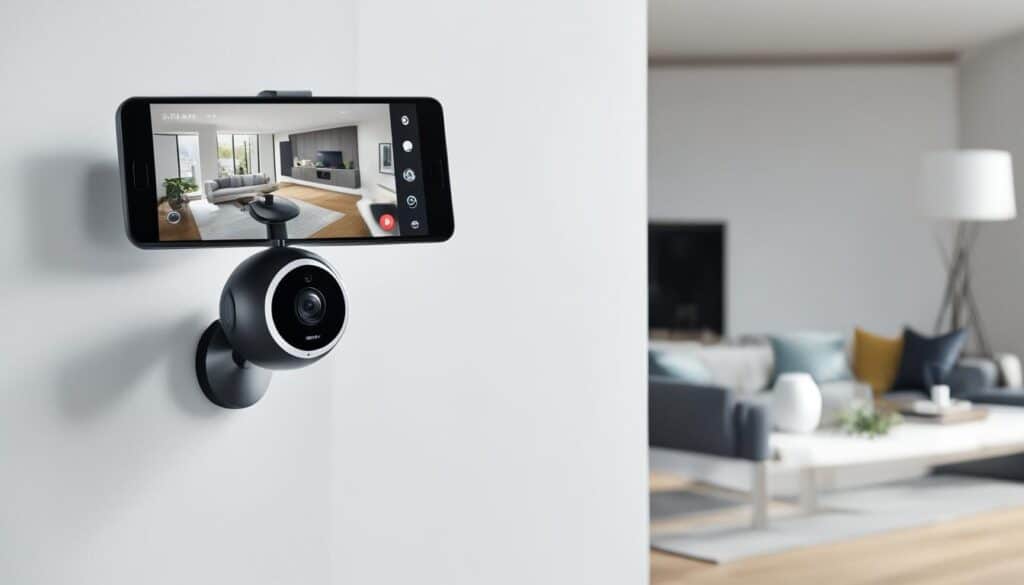When it comes to setting up a smart home security system, choosing the right cameras is crucial, especially for beginners. With the wide variety of options available in the market, it can be overwhelming to make the right choice. In this article, I will guide you through the process of selecting the best smart home cameras for beginners, ensuring that you make an informed decision that suits your needs and preferences.
Table of Contents
Key Takeaways:
- Choosing the right smart home camera is essential for beginners to ensure effective security monitoring.
- Evaluate factors such as resolution, field of view, connectivity, storage, and compatibility when making a choice.
- Types of cameras for beginners include indoor cameras, outdoor cameras, doorbell cameras, and wireless cameras.
- Key features to look for in smart home cameras include motion detection, night vision, two-way audio, remote access, and control.
- Recommended smart home cameras for beginners include Arlo Pro 3, Google Nest Cam IQ Indoor, Ring Stick Up Cam Battery, Wyze Cam V3, and Blink Mini.
Factors to Consider When Choosing Smart Home Cameras
Before diving into the different camera options, it’s essential to consider a few factors that will help narrow down your choices. These include the camera’s resolution, field of view, connectivity features, storage options, and compatibility with other smart home devices. By evaluating these factors, you can determine which cameras align with your specific requirements and make the best choice for your home security system.
Resolution
The resolution of a smart home camera determines the quality of the images and videos it captures. Higher resolution cameras offer clearer and more detailed visuals, allowing you to see important details more clearly. When choosing a camera, opt for models with at least 1080p resolution for optimal image quality.
Field of View
The field of view refers to the extent of the area that a camera can cover. Cameras with a wider field of view can monitor a larger area, reducing the number of cameras you need for comprehensive coverage. Consider the layout of your home and the areas you want to monitor when selecting a camera with an appropriate field of view.
Connectivity Features
Smart home cameras offer various connectivity features that enhance their functionality. Look for cameras that support Wi-Fi connectivity, as this allows for easy remote access and viewing through a mobile app. Additionally, consider cameras with Ethernet ports or Power over Ethernet (PoE) support for a more stable and reliable connection.
Storage Options
When it comes to storing recorded footage, smart home cameras offer different options. Some cameras come with built-in storage, typically in the form of a microSD card slot, allowing you to save footage directly to the camera itself. Alternatively, cameras may offer cloud storage subscriptions for convenient access to saved recordings. Consider your preference for local or cloud storage and choose a camera accordingly.
Compatibility with Other Smart Home Devices
If you already have other smart home devices, such as smart lights or a home security system, it’s important to choose cameras that are compatible with your existing ecosystem. Look for cameras that can integrate and work seamlessly with popular smart home platforms like Amazon Alexa or Google Assistant.
| Factors to Consider | Description |
|---|---|
| Resolution | The quality of the images and videos captured by the camera. |
| Field of View | The extent of the area that the camera can cover. |
| Connectivity Features | Wi-Fi connectivity, Ethernet ports, or Power over Ethernet (PoE) support. |
| Storage Options | Built-in storage or cloud storage subscriptions. |
| Compatibility with Other Smart Home Devices | Integration with popular smart home platforms. |
Types of Smart Home Cameras for Beginners
When it comes to smart home security, beginners have a variety of camera options to choose from. Understanding the different types of smart home cameras and their unique features is essential for making an informed decision. Let’s explore the various types designed specifically for beginners:
1. Indoor Cameras
Indoor cameras are ideal for monitoring the inside of your home. They provide a clear view of your living spaces, allowing you to keep an eye on your property while you’re away. These cameras are typically easy to install and can be placed on shelves, countertops, or mounted on walls.
2. Outdoor Cameras
For monitoring the exterior of your home, outdoor cameras are the perfect choice. Designed to withstand the elements, these cameras provide surveillance and security for your outdoor spaces, such as your backyard, driveway, or front porch. They often come with weatherproof casing and night vision capabilities.
3. Doorbell Cameras
Doorbell cameras offer a convenient solution for monitoring your front door. These cameras are integrated into your doorbell system and provide real-time video and audio feed when someone approaches your door. They allow you to communicate with visitors remotely and enhance your home’s security.
4. Wireless Cameras
Wireless cameras provide flexibility in terms of installation and placement. These cameras connect to your home Wi-Fi network, eliminating the need for complex wiring. You can easily move them around or install them in hard-to-reach areas, enhancing your home security options.
By understanding the different types of smart home cameras available for beginners, you can choose the right cameras that align with your specific security needs. Each type offers unique features and benefits, providing you with peace of mind and enhanced control over your home security system.
“Choose the right smart home camera type to suit your security needs and preferences.”
| Camera Type | Features | Advantages |
|---|---|---|
| Indoor Cameras | Clear view of indoor spaces, easy installation | Monitor your home while you’re away |
| Outdoor Cameras | Weatherproof, night vision capabilities | Surveillance and security for outdoor spaces |
| Doorbell Cameras | Real-time video and audio feed, remote communication | Convenient monitoring of your front door |
| Wireless Cameras | Flexible installation, easy relocation | Enhanced control over camera placement |
Key Features to Look for in Smart Home Cameras
When it comes to choosing smart home cameras, it’s important to consider the key features that will enhance your overall experience and provide effective security monitoring. By selecting cameras with these features, you can ensure optimal functionality and convenience for your smart home security system.
Motion Detection
One of the essential features to look for in smart home cameras is motion detection. This technology allows the camera to detect any movement within its field of view and send alerts to your smartphone or other connected devices. With motion detection, you can receive instant notifications and quickly assess any potential security threats.
Night Vision
Ensure that the smart home cameras you choose have night vision capabilities. This feature enables the cameras to capture clear and detailed footage, even in low-light or completely dark conditions. With night vision, you can monitor your home 24/7 and maintain reliable security, regardless of the time of day.
Two-Way Audio
Another valuable feature to consider is two-way audio. With this functionality, you can communicate with anyone in the vicinity of the camera through a built-in speaker and microphone. Whether it’s talking to a family member or warding off an intruder, two-way audio provides an additional layer of security and convenience.
Remote Access and Control
When selecting smart home cameras, ensure that they offer remote access and control. This allows you to monitor your cameras and access live or recorded footage from anywhere, using your smartphone or other internet-connected devices. With remote access and control, you can keep an eye on your home even when you’re away.
Compatibility with Voice Assistants
Consider choosing smart home cameras that are compatible with popular voice assistants like Amazon Alexa or Google Assistant. This compatibility allows you to control your cameras using voice commands, making it even more convenient to monitor your home. Simply ask your voice assistant to show the camera feed on your smart display or TV.
“By selecting smart home cameras with motion detection, night vision, two-way audio, remote access and control, and voice assistant compatibility, you can create a comprehensive and convenient home security system that meets your specific needs.”
Now that you know the key features to look for in smart home cameras, you can make an informed decision and choose the cameras that align with your security requirements. In the next section, we will explore the best smart home cameras for beginners, considering these essential features.
Best Smart Home Cameras for Beginners
After thorough research and analysis, I have identified some of the best smart home cameras for beginners. These include:
- Arlo Pro 3
- Google Nest Cam IQ Indoor
- Ring Stick Up Cam Battery
- Wyze Cam V3
- Blink Mini
Each of these cameras offers unique features, excellent image quality, easy installation, and seamless integration with your smart home ecosystem. With the Arlo Pro 3, you get advanced motion detection, 2K HDR video, and a convenient wire-free design. The Google Nest Cam IQ Indoor boasts facial recognition, crisp 1080p HD video, and built-in Google Assistant. The Ring Stick Up Cam Battery provides versatile indoor/outdoor use, battery-powered convenience, and customizable motion zones. The Wyze Cam V3 delivers impressive night vision, 1080p full HD video, and compatibility with Alexa and Google Assistant. Lastly, the Blink Mini offers affordable HD video, two-way audio, and hassle-free setup.

By considering these options, you can find the perfect camera to ensure the security and peace of mind for your home.
Installation and Set-Up of Smart Home Cameras
Once you have chosen the right smart home cameras for your needs, it’s important to understand the installation and set-up process. Most cameras come with simple instructions and easy-to-use mobile apps that guide you through the process.
Follow these steps to install and set up your smart home cameras:
- Connect the camera to your Wi-Fi network: Start by connecting the camera to your home Wi-Fi network. This step is usually done through the camera’s mobile app, where you can enter your Wi-Fi network name and password.
- Position and mount the camera: Decide on the optimal location for your camera, whether it’s indoors or outdoors. Make sure the camera has a clear view of the area you want to monitor. Use the mounting equipment provided by the manufacturer to securely attach the camera to a wall, ceiling, or other suitable surfaces.
- Configure the settings and preferences: Once the camera is connected and mounted, you may need to configure certain settings and preferences. This can include adjusting the camera’s motion detection sensitivity, setting up activity zones, enabling night vision, and customizing notifications. Check the camera’s mobile app or user manual for specific instructions on how to customize settings.

By following the manufacturer’s instructions and using the provided mobile app, you can have your smart home cameras up and running in no time. Take the time to properly install and configure your cameras to ensure optimal performance and reliable security for your home.
Conclusion
In conclusion, when you are choosing the best smart home cameras for beginners, it is important to consider various factors such as resolution, field of view, connectivity, storage, and compatibility. By understanding the different types of cameras available and their key features, you can make an informed decision that suits your specific needs.
Based on my research and analysis, I recommend the following cameras for beginners: Arlo Pro 3, Google Nest Cam IQ Indoor, Ring Stick Up Cam Battery, Wyze Cam V3, and Blink Mini. These cameras offer excellent performance and seamless integration with your smart home ecosystem, ensuring reliable security and peace of mind.
Once you have chosen the right camera, it is crucial to follow the proper installation and set-up process. Most cameras come with easy-to-use instructions and user-friendly mobile apps that guide you through the process. By carefully following the instructions and configuring the settings, you can have your smart home cameras up and running in no time.
By prioritizing your needs, understanding the features, and selecting the best cameras, you can create a comprehensive smart home security system that enhances the safety and protection of your home. Invest in the right smart home cameras for beginners, and enjoy the convenience and peace of mind that comes with advanced home surveillance technology.
FAQ
What factors should I consider when choosing smart home cameras?
When choosing smart home cameras, it’s important to consider factors such as resolution, field of view, connectivity features, storage options, and compatibility with other smart home devices.
What are the different types of smart home cameras available for beginners?
There are several types of smart home cameras available for beginners, including indoor cameras, outdoor cameras, doorbell cameras, and wireless cameras.
What key features should I look for in smart home cameras?
When choosing smart home cameras, it’s important to look for key features such as motion detection, night vision, two-way audio, remote access and control, and compatibility with voice assistants.
What are some of the best smart home cameras for beginners?
Some of the best smart home cameras for beginners include the Arlo Pro 3, Google Nest Cam IQ Indoor, Ring Stick Up Cam Battery, Wyze Cam V3, and Blink Mini.
How do I install and set up smart home cameras?
Most smart home cameras come with simple instructions and easy-to-use mobile apps that guide you through the installation and set-up process. It typically involves connecting the camera to your Wi-Fi network, positioning and mounting the camera in the desired location, and configuring the settings and preferences through the app.
Source Links
- https://www.droidmen.com/unveiling-the-best-drones-for-kids/
- https://robots.net/digital-media-and-creative-tech/digital-photography/why-dslr-cameras-are-better-than-phone-cameras/
- https://tulsaworld.com/news/nation-world/business/kim-komando-5-smart-simple-tech-changes-to-make-2024-better/article_d2225472-aa6d-11ee-8a03-df0c98156ec8.html


